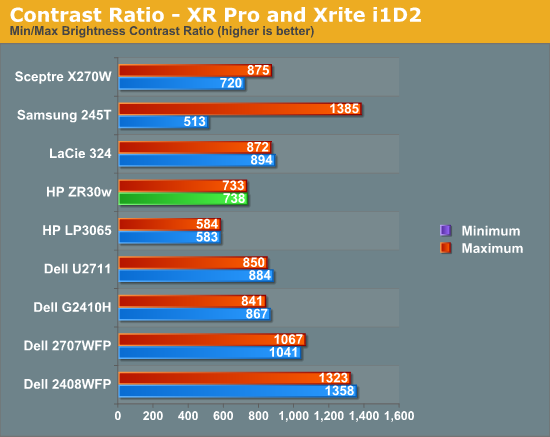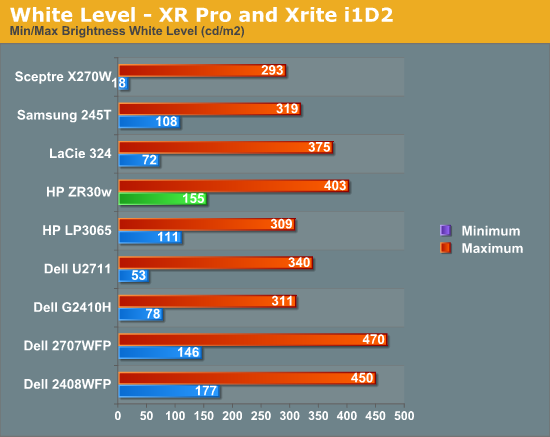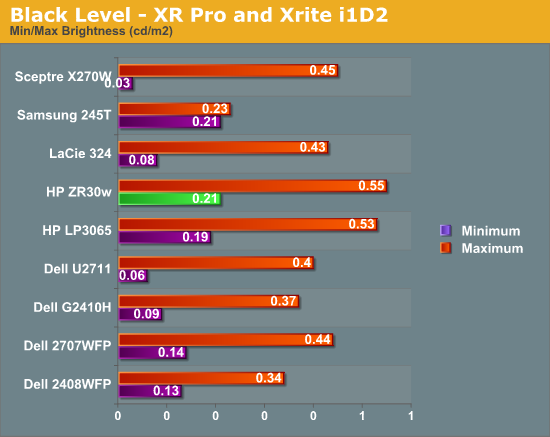A New 30" Contender: HP ZR30w Review
by Brian Klug on June 1, 2010 6:30 PM EST
Brightness and Contrast
For brightness, black level, and contrast points, we use the same colorimeter setup described earlier. Specifically, we use an Xrite i1D2 with ColorEyes Display Pro, and take measurements at maximum and minimum brightness of white and black targets. Dynamic contrast is turned off. We also let the panels settle in for a half hour at the respective settings before taking any measurements.
The ZR30w uses a CCFL backlight, which makes that warm up time even more critical. In practice, the display reached the target brightness relatively quickly, and settled in within a few nits after 15 minutes.



Black level is an important metric, since it directly represents the extinction ratio of the crossed polarizers in each pixel. Remember, when a pixel is desired to be black, the photoelectric crystal in the cell changes linearly polarized light 90 degrees out of phase, so it is blocked by the polarizer. Higher extinction ratios (and thus better crystals and materials) result in lower (better) black levels.
We recommend running monitors at around 200 nits of luminous intensity, just because this is often where some of the best color tracking sits, and it’s enough of a balance to not result in eye stress from looking around the room and having your pupil adjust. I mentioned earlier that the controls on the ZR30w give you between 150 nits and just over 400. It’s obvious that HP wants you to run this thing on the brighter side, and I tend to agree.
The charts show the dynamic range in brightness, and the respective black levels at each brightness. White brightness is beyond the rated 370 nits at a maximum of 403 nits.
What we’re really interested in, however, is the contrast ratio. At the extreme, we fall short of 1000:1 with 733 and 738 at both ends of the display’s brightness range. This is good performance nonetheless, but I had expected a bit more. Keep in mind when comparing black levels on that graph that the other panels may indeed go darker, but at substantially lower brightness levels.










95 Comments
View All Comments
phoible_123 - Tuesday, June 1, 2010 - link
Will this connect directly to a Macbook pro with a mini displayport -> displayport cable?I've been able to connect a MBP to other displayport monitors, and would like to know whether you can drive a dual-link display this way.
Brian Klug - Tuesday, June 1, 2010 - link
I spent a greater part of today searching around town for a miniDP to DP adapter, but couldn't find that nor the cables. I'm under the impression that it will work, and might even pass the 10-bit deep color data too. I'm hopefully getting an adapter soon.Cheers,
Brian
kasakka - Thursday, June 3, 2010 - link
I have a Dell 3008WFP that I've connected to my late 2009 Macbook Pro with a mini-Displayport to Displayport cable using this cable:http://estore.circuitassembly.com/products/Mini-Di...
It works perfectly and avoids the issues with the overpriced Apple mini-DP to dual link DVI adapter.
Brian Klug - Wednesday, June 9, 2010 - link
Hey, just letting you know that the ZR30w does work driven from the 2010 MBP over a mini Display Port to Display Port cable. Flawlessly, really. No problems at all thus far!Cheers,
Brian
Mishaux - Monday, May 21, 2012 - link
Hey Brian,I realize this is a few years late, but I am trying to make this work with a mid 2010 15" MBP and having no luck. Did you have to do anything other than plug it in?
Thanks!
Mumrik - Tuesday, June 1, 2010 - link
Nine bucks for a G520!?!??!Screw LCDs :-D
Bolas - Tuesday, June 1, 2010 - link
So... what's the refresh rate? 60 Hz? 75 Hz? 120 Hz? 240 Hz? I didn't see the refresh rate on the table of specifications, and that would be something worth knowing for people in the market for a high res 3D display.Brian Klug - Tuesday, June 1, 2010 - link
The refresh rate over DVI is still 60 Hz, at least as reported in the display manager.Cheers,
Brian
GoodBytes - Tuesday, June 1, 2010 - link
60Hz, it's always 60Hz for computer monitor using IPS or PVA panels.. well today... it might change later.Bolas - Tuesday, June 1, 2010 - link
I figured it was 60 Hz, but you'd think that they would spell that out in the specs. Pity it doesn't have pivot feature, but whatever.